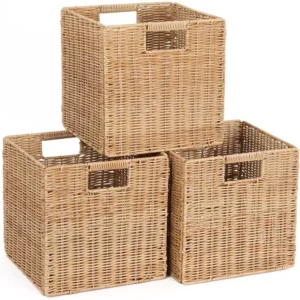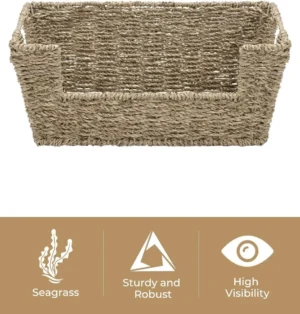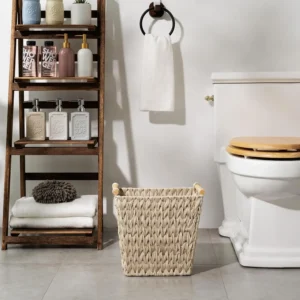Understanding Wicker and Your Basket
When it comes to caring for your beautiful home storage solutions, understanding what wicker actually is makes all the difference. Contrary to popular belief, wicker isn’t a material but rather a weaving technique used to create baskets and furniture. This technique can be applied to various materials, both natural and synthetic.
Natural wicker materials include:
– Rattan: A flexible, vine-like palm species
– Bamboo: Strong, lightweight woody stems
– Willow: Flexible branches ideal for traditional weaving
– Seagrass: Durable, water-resistant natural fiber
Synthetic wicker options include:
– Resin: Weather-resistant plastic that mimics natural fibers
– Vinyl: Durable plastic material that resists moisture
Proper cleaning ensures your wicker baskets maintain their beauty and structural integrity for years to come. The cleaning methods you choose should align with your specific basket material. For instance, natural fibers require more gentle moisture control, while synthetic materials can withstand more rigorous cleaning.
At Tidy Treasure, our commitment to quality wicker means selecting pieces that not only look beautiful but can be maintained for years with proper care. Understanding how to clean and maintain your organizing laundry wicker baskets is essential for preserving their beauty, while knowing which wicker baskets you own helps determine the right cleaning approach.
Essential Cleaning Supplies for Wicker Care
Before beginning the cleaning process, gather these essential tools to ensure you clean your wicker baskets effectively without causing damage:
Essential Tools:
– Soft-bristled brush: Perfect for removing dust from woven crevices without scratching
– Microfiber cloths: Gentle for wiping surfaces without snagging fibers
– Handheld vacuum with brush attachment: Removes dust from hard-to-reach crevices
– Spray bottle: For controlled application of cleaning solutions
– Small bowl: For mixing cleaning solutions
– Toothbrush or cotton swabs: For cleaning tight corners and intricate weaves
Optional Tools:
– Compressed air can: Ideal for blowing dust from tight weaves
– Fan: Assists with proper drying after cleaning
– Soft towels: For blotting excess moisture
For natural wicker, choose tools that apply minimal moisture and won’t catch on delicate fibers. Synthetic wicker can handle slightly stiffer brushes, but still benefits from gentle treatment to preserve its appearance.
Having the right tools on hand makes the cleaning process more efficient and helps protect your baskets from damage. The techniques you’ll learn here can also be applied when you need to restore old woven baskets that may need more intensive care.
Pre-Cleaning Assessment: Know Your Basket
Before you begin cleaning, take a moment to assess your wicker basket. This step ensures you’ll use the appropriate cleaning method without causing damage.
Material Identification Checklist:
– Look at fiber texture: Natural fibers have slight irregularities; synthetics appear more uniform
– Check flexibility: Natural wicker feels more organic and may have minor variations
– Examine color: Natural wicker has subtle color variations; synthetic tends to be more consistent
– Water test: Place a tiny drop in an inconspicuous spot—natural wicker absorbs moisture while synthetic repels it
Next, determine the level of cleaning needed:
– Light cleaning: Regular dusting and occasional spot cleaning
– Deep cleaning: For visibly soiled baskets with accumulated dirt
– Mold removal: Required for baskets with visible mold spots or musty odors
Always check for pre-existing damage like loose weaves, broken strands, or weak spots before cleaning. These areas require gentle handling to prevent further damage.
Before applying any cleaning solution, test it on a small, hidden area of your basket and wait 5-10 minutes to ensure no discoloration occurs.
Understanding your specific basket type, such as our collection of rattan baskets, helps determine the most effective and safe cleaning approach for long-term preservation.

Routine Cleaning for Wicker Baskets
Regular maintenance prevents dirt buildup and extends your basket’s lifespan. Follow these steps for effective routine cleaning:
Start by taking your basket outside or placing it over newspaper to catch falling debris.
Using a soft-bristled brush or vacuum with brush attachment, gently dust the basket following the direction of the weave. Pay special attention to crevices where dust collects. For hard-to-reach areas, a clean paintbrush works wonderfully.
For slightly dirty areas, lightly dampen a microfiber cloth with water and gently wipe the surface. Remember that less moisture is better, especially for natural wicker.
For minor spots, mix a small amount of mild dish soap with water, dip a soft cloth, and wring until barely damp. Gently wipe the affected area and immediately dry with a clean towel.
Allow the basket to air dry completely before returning it to use. Never put wicker away damp as this can lead to mold growth.
Aim to dust your wicker baskets weekly and perform this light cleaning monthly, depending on use. Baskets in high-traffic areas or those used for effortless laundry organization might need more frequent attention due to regular handling.
Deep Cleaning Heavily Soiled Wicker
When your wicker baskets develop stubborn dirt or stains, it’s time for a more thorough cleaning approach. Here’s how to deep clean without causing damage:
Prepare your cleaning solution based on your basket type:
– For natural wicker: Mix 1 part white vinegar with 4 parts warm water
– For synthetic wicker: Mix 1 tablespoon mild dish soap with 1 gallon of warm waterAlways test your solution on an inconspicuous area and wait 15 minutes to ensure no discoloration.
Dip a soft cloth or brush into your cleaning solution, wring out excess moisture until damp (not wet), and gently clean along the weave pattern.
For natural wicker, work quickly and avoid saturating the fibers. Clean one small section at a time.
For synthetic wicker, you can be slightly more generous with moisture but still avoid soaking.
After cleaning with the solution, wipe down the basket with a clean, damp cloth to remove soap or vinegar residue.
Immediately dry with clean towels, blotting rather than rubbing to protect the weave.
Allow the basket to air dry completely for at least 24-48 hours in a well-ventilated area before using again.
Never submerge natural wicker completely in water, as this can cause warping and weakening of the fibers. For wicker storage baskets that hold heavier items, proper cleaning ensures they maintain their structural integrity over time.
Removing Mold and Mildew from Wicker
Mold and mildew not only look unsightly but can also damage your wicker baskets and potentially affect your health. Here’s how to safely remove these unwanted growths:
Safety First:
Always work in a well-ventilated area when dealing with mold. Consider wearing gloves and a mask, especially if you have respiratory sensitivities.
For Natural Wicker:
1. Take the basket outdoors and brush away as much visible mold as possible with a soft brush.
Mix a solution of 1 part white vinegar to 1 part water in a spray bottle.
Lightly spray the affected areas—don’t saturate the wicker.
Allow the vinegar solution to sit for 5-10 minutes to kill mold spores.
Gently scrub the area with a soft brush, following the weave pattern.
Wipe clean with a slightly damp cloth, then dry thoroughly with a clean towel.
Place the basket in bright, indirect sunlight which naturally helps kill remaining mold spores.
For Synthetic Wicker:
1. Mix a solution of 1 tablespoon of bleach to 1 gallon of water.
Apply the solution with a cloth to affected areas only.
Let sit for 5 minutes, then scrub gently with a soft brush.
Rinse thoroughly by wiping with a clean, damp cloth several times.
Dry completely with towels and fresh air.
To prevent future mold growth, keep wicker baskets in dry areas with good air circulation. This is particularly important for wicker laundry baskets that might be used in humid bathroom environments.
Material-Specific Cleaning Techniques
Different wicker materials require tailored cleaning approaches to preserve their unique characteristics and extend their lifespan.
Natural Wicker Materials:
Rattan:
– Use minimal moisture as rattan can absorb water and weaken
– Clean with a barely damp cloth and dry immediately
– Apply a light coat of lemon oil once yearly to maintain flexibility
Bamboo:
– More water-resistant than other natural materials
– Can handle slightly damper cleaning cloths
– Responds well to a mixture of mild soap and water
Willow:
– Extremely susceptible to water damage
– Clean primarily with dry methods (dusting, vacuuming)
– When needed, use a barely damp cloth and dry immediately
Seagrass:
– Naturally more resistant to moisture
– Clean spills immediately to prevent staining
– Avoid over-saturating the tight weave which can trap moisture
Synthetic Wicker Materials:
Resin:
– Can handle more direct cleaning with soap and water
– Resistant to mold and mildew
– Can be rinsed with a gentle hose spray (low pressure)
Vinyl:
– Highly water-resistant
– Can be cleaned with standard household cleaners
– Responds well to soft scrub brushes for stubborn dirt
Painted or Stained Wicker:
– Always test cleaning solutions on an inconspicuous area first
– Use very mild soap solutions to avoid damaging the finish
– Never use abrasive cleaners that could scratch the surface
Understanding these material differences helps ensure your wicker laundry basket storage solutions remain beautiful and functional for years to come.
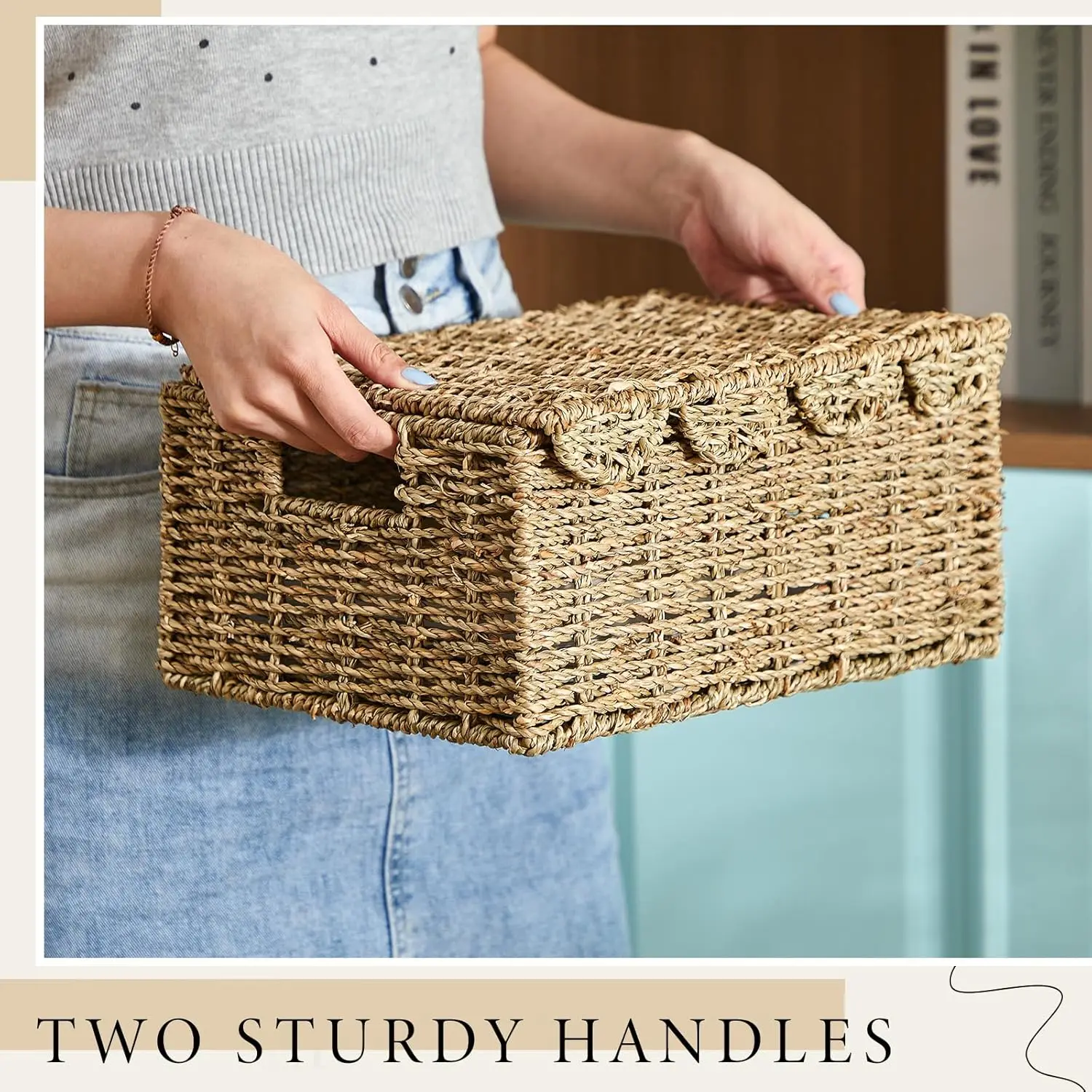
Proper Drying Techniques for Wicker Baskets
Thorough drying is perhaps the most crucial step in wicker basket care. Improper drying can lead to mold, mildew, warping, and structural damage.
Best Drying Practices:
– Place baskets in a well-ventilated area with good air circulation
– Position baskets so air can flow around and through the weave
– Rotate occasionally during drying to ensure even air exposure
– Allow natural wicker to dry completely for 24-48 hours before using
– Use fans to improve air circulation (but avoid direct heat)
– Limited sun exposure (15-20 minutes) can help dry and naturally disinfect
Drying Don’ts:
– Never use hair dryers, heaters, or other direct heat sources
– Avoid placing wet baskets in direct sunlight for extended periods
– Don’t stack or nest damp baskets
– Never store baskets until completely dry
– Don’t rush the drying process
Testing for Dryness:
Touch the basket in several spots, paying special attention to the bottom and tight weaves. If it feels cool to the touch, it likely still contains moisture. A completely dry basket should feel room temperature and have no musty smell.
For wicker baskets with lids, ensure you dry both pieces separately with lids removed to prevent trapped moisture between the surfaces.
Restoring and Maintaining Wicker Beauty
Beyond basic cleaning, several techniques can restore and maintain your wicker baskets’ beauty and flexibility.
For natural wicker that’s become dry and brittle:
1. Mix equal parts lemon oil and water in a spray bottle
2. Lightly mist the basket (don’t saturate)
3. Gently wipe with a soft cloth
4. Allow to air dry
This treatment helps restore moisture and flexibility to natural fibers while adding a subtle sheen.
Natural Shine Restoration:
– For food-safe options, apply a small amount of food-grade mineral oil with a cloth
– For decorative baskets, furniture polish formulated for wicker works well
– Always apply sparingly and buff with a clean cloth
Odor Elimination:
– Place baking soda in a shallow dish inside the basket for 24-48 hours
– For stubborn odors, place the basket in fresh air and sunshine for several hours
– Avoid scented sprays that may leave residue on the fibers
Maintenance Schedule:
– Dust weekly
– Spot clean as needed
– Deep clean quarterly
– Condition natural wicker twice yearly
– Inspect for damage monthly
Regular maintenance keeps your best wicker baskets for laundry organization looking beautiful while extending their functional life.
Black Wicker Baskets, Rattan Storage Baskets, Tall Wicker Baskets, Wicker Shelf Baskets, Woven Storage Baskets
5-Tier Distressed Black Wood Frame Storage Tower with Removable Wicker Baskets for Home Organization$715.80 Select options This product has multiple variants. The options may be chosen on the product pageWicker Laundry Baskets, Woven Laundry Baskets, Woven Storage Baskets
$392.02 Select options This product has multiple variants. The options may be chosen on the product pageRattan Shelf Baskets, Rattan Storage Baskets, Small Wicker Baskets, Square Wicker Baskets
Square Plastic Wicker Storage Baskets Set of 3 with Collapsible Design for Cube Storage Organization$185.47 Select options This product has multiple variants. The options may be chosen on the product pageWicker Baskets with Handles, Wicker Storage Baskets, Woven Storage Baskets
$137.92 Select options This product has multiple variants. The options may be chosen on the product page- $119.02 Select options This product has multiple variants. The options may be chosen on the product page
Large Wicker Laundry Baskets, Tall Wicker Baskets, Woven Laundry Hampers, Woven Storage Baskets
$130.54 Select options This product has multiple variants. The options may be chosen on the product page
Preventing Damage During Cleaning
Knowing what to avoid is just as important as knowing the proper cleaning techniques. Here are essential do’s and don’ts to protect your wicker during cleaning:
Do:
– Work with the weave pattern, not against it
– Use soft, lint-free cloths for cleaning
– Test cleaning solutions on hidden areas first
– Clean spills immediately to prevent staining
– Support the basket structure while cleaning
– Allow complete drying between cleaning steps
Don’t:
– Soak or submerge natural wicker in water
– Use bleach on natural fibers
– Scrub aggressively with stiff brushes
– Apply excess pressure to weak or damaged areas
– Use oil-based products on painted wicker
– Rush the cleaning process
– Use hot water that can weaken adhesives
One common mistake is over-wetting natural wicker, which causes fibers to swell and then shrink as they dry, weakening the overall structure. Always use the minimum moisture needed for effective cleaning.
Handle your baskets with care during cleaning, supporting the bottom and sides to prevent stress on the weave. Understanding what you can store in a wicker basket helps determine how gentle your cleaning approach needs to be, especially for baskets that hold heavier items.
Seasonal Care for Wicker Baskets
Wicker baskets require different care approaches throughout the year to combat seasonal challenges. Adapting your maintenance routine by season helps preserve their beauty and structural integrity.
Spring/Summer Care:
– Monitor humidity levels, especially in rainy seasons
– Keep natural wicker baskets away from consistently damp areas
– Allow extra ventilation during humid months
– Check more frequently for mold development
– Consider using dehumidifiers in storage areas
Fall/Winter Care:
– Prevent excessive drying in heated indoor environments
– Maintain indoor humidity between 40-50% when possible
– Condition natural wicker more frequently during heating season
– Keep baskets away from direct heat sources like radiators
– Dust more often due to closed windows and heating systems
Seasonal Storage Tips:
– Clean thoroughly before seasonal storage
– Store in climate-controlled areas when possible
– Never store in attics, garages, or basements with humidity fluctuations
– Cover with cotton sheets, never plastic (which traps moisture)
– Place acid-free tissue paper in baskets to help maintain shape
The optimal humidity range for wicker preservation is 40-60%. Levels consistently above or below this range can damage your baskets over time. Proper storing of rattan baskets between seasons ensures they remain beautiful for years to come.
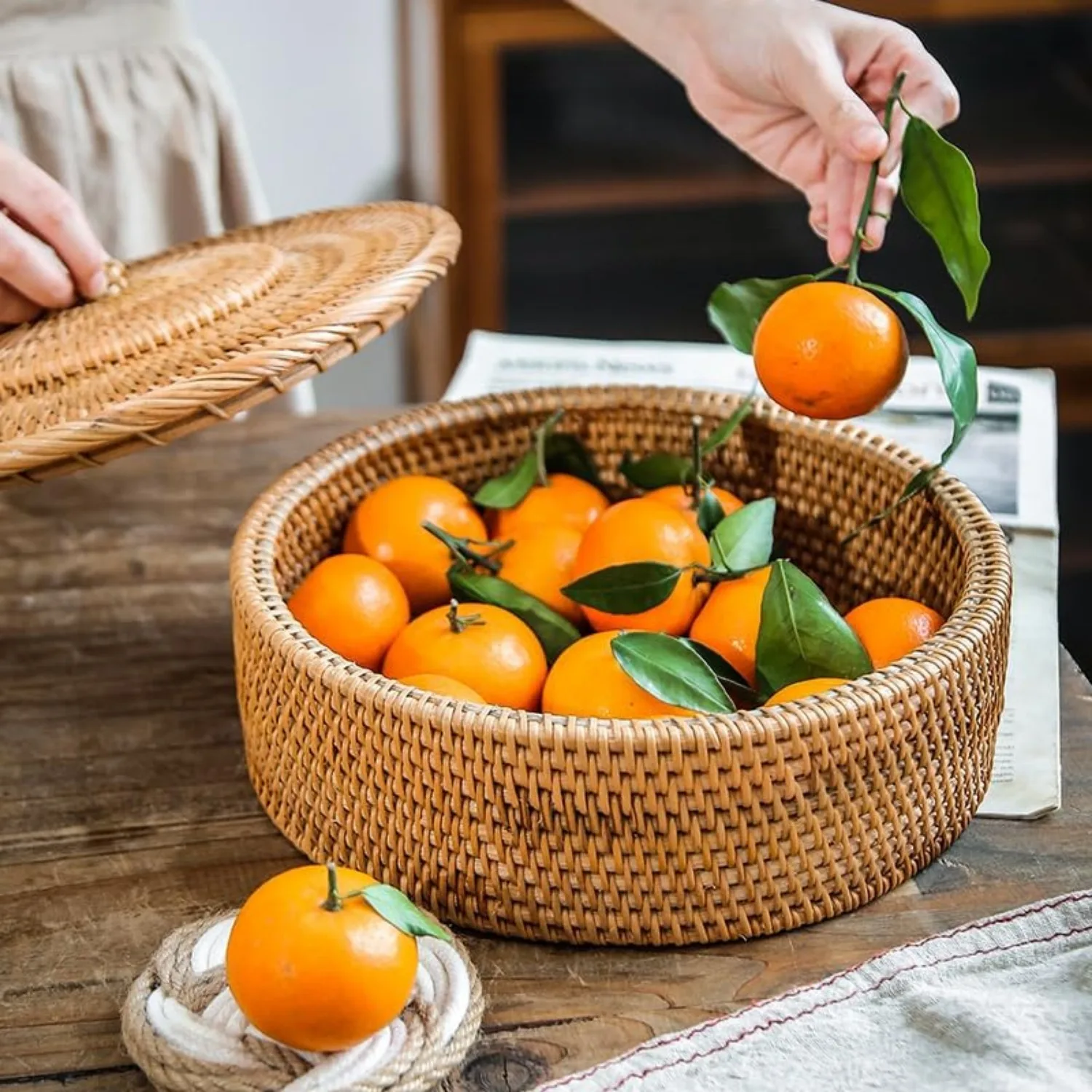
Frequently Asked Questions About Wicker Cleaning
How often should I clean my wicker baskets?
Dust weekly, spot clean as needed, and deep clean every 3-4 months. Baskets in high-traffic areas or those used for storage may require more frequent attention.
Can water damage my wicker basket permanently?
Yes, especially natural wicker. Excessive moisture can cause warping, weakening, mold growth, and structural damage. Always use minimal moisture and ensure thorough drying.
How do I clean antique or valuable wicker baskets?
Use extra caution with minimal moisture. Consider consulting a restoration specialist for valuable pieces. Focus on gentle dusting and spot cleaning rather than deep cleaning.
What cleaning products should I avoid?
Avoid harsh chemicals, bleach (on natural fibers), ammonia-based cleaners, abrasive scrubbers, oil-based polishes on painted wicker, and furniture sprays containing silicone.
How can I tell if discoloration is damage or normal aging?
Natural aging typically produces even, amber-toned darkening. Damage appears as irregular dark spots, black marks, or white discoloration. Normal aging doesn’t affect structural integrity, while damage often does.
For baskets used in specific areas like bathrooms, understanding how to care for wicker waste baskets can help address unique cleaning challenges they face in moisture-prone environments.




